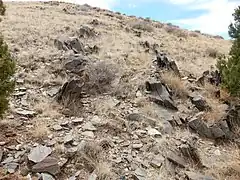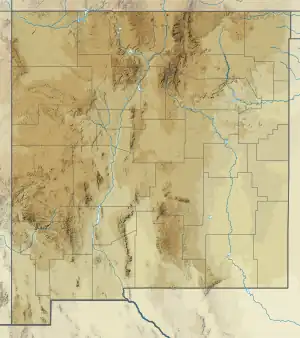| Sevilleta Metarhyolite | |
|---|---|
| Stratigraphic range: | |
 Sevilleta Metarhyolite west of Abo Pass, New Mexico, US | |
| Type | Formation |
| Unit of | Manzano Group |
| Underlies | Abajo Formation |
| Overlies | Bootleg Canyon Sequence |
| Thickness | 4,500 ft (1,400 m) |
| Lithology | |
| Primary | Rhyolite |
| Other | Schist, amphibolite |
| Location | |
| Coordinates | 34°24′29″N 106°31′30″W / 34.408°N 106.525°W |
| Region | Los Pinos Mountains, New Mexico |
| Country | United States |
| Type section | |
| Named for | Sevilleta land grant, Socorro County, New Mexico |
| Named by | Stark and Dapples |
| Year defined | 1946 |
 Sevilleta Metarhyolite (the United States)  Sevilleta Metarhyolite (New Mexico) | |
The Sevilleta Metarhyolite (or Sevilleta Formation) is a geologic formation in central New Mexico. It has a radiometric age of 1665 ± 16 Ma, corresponding to the Statherian period.
History of investigation
The unit was first defined by Stark and Dapples in 1959, during their mapping of the Los Pinos Mountains, as the Sevilleta rhyolite.[1] Condie and Budding called the unit the Sevilleta Formation in their 1979 work.[2] Bauer and Pollock called the unit the Sevilleta metarhyolite in their compilation of radiometric ages in 1993.[3]
Geology
The unit is a thick sequence of interbedded metarhyolites, pelitic schists, and amphibolites. The metarhyolite making up the bulk of the unit is a tan to dark red, glassy, fine-grained metarhyolite with abundant potassium feldspar phenocrysts. The modal composition is 25% quartz, 30% plagioclase, 40% potassium feldspar, 1% muscovite, 1% biotite, 1% epidote, 1% oxides, and 1% accessory minerals. Accessory minerals include actinolite, chlorite, carbonate minerals, and zircon. Radiometric ages range from 1658 Ma to 1670 Ma with a consensus age of 1662±1 Ma.[4]
The formation is included in the Manzano Group. It overlies the Bootleg Canyon Sequence and is in turn overlain by the Abajo Formation.[5]
Similar beds are found in the Hells Canyon area of the northern Manzanita Mountains (34°53′31″N 106°24′11″W / 34.892°N 106.403°W) and the Monte Largo Hills (35°10′59″N 106°16′41″W / 35.183°N 106.278°W). However, the Hells Canyon outcrops may be older than the main exposures of the unit. [4]
The unit is interpreted as a product of caldera eruptions associated with the Mazatzal orogeny.[6]
Footnotes
References
- Bauer, P.W.; Pollock, T.R. (1993). "Compilation of Precambrian isotopic ages in New Mexico" (PDF). New Mexico Bureau of Mines and Mineral Resources Open File Report. 389. Retrieved 3 June 2021.
- Condie, K.C.; Budding, A.J. (1979). "Geology and geochemistry of Precambrian rocks, central and south-central New Mexico". New Mexico Bureau of Mines and Mineral Resources Memoir. 35. Retrieved 3 June 2021.
- Holland, Mark E.; Grambling, Tyler A.; Karlstrom, Karl E.; Jones, James V.; Nagotko, Kimberly N.; Daniel, Christopher G. (September 2020). "Geochronologic and Hf-isotope framework of Proterozoic rocks from central New Mexico, USA: Formation of the Mazatzal crustal province in an extended continental margin arc". Precambrian Research. 347: 105820. doi:10.1016/j.precamres.2020.105820.
- Grambling, Tyler A.; Karlstrom, Karl E.; Holland, Mark E.; Grambling, Nadine L. (2016). "Proterozoic magmatism and regional contact metamorphism in the Sandia-Manzano Mountains, New Mexico, USA" (PDF). New Mexico Geological Society Field Conference Series. 67: 169–175. Retrieved 27 May 2020.
- Stark, J. T.; Dapples, E. C. (1946). "GEOLOGY OF THE LOS PINOS MOUNTAINS, NEW MEXICO". Geological Society of America Bulletin. 57 (12): 1121. doi:10.1130/0016-7606(1946)57[1121:GOTLPM]2.0.CO;2.